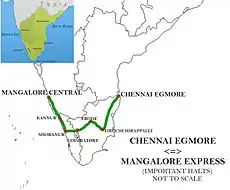Chennai Egmore–Mangalore Central Express
Chennai Egmore–Mangalore Central Express is an express train connecting Chennai in Tamil Nadu, India with Mangalore in Karnataka, India. The main cities it passes through are Chennai Egmore, Villuppuram, Tiruchirappalli, Karur, Erode, Coimbatore, Palakkad, Tirur (Malappuram), Kozhikode, Kannur, Kasargod and Mangalore
| Overview | |
|---|---|
| Service type | Express train |
| Status | Operating |
| Locale | Tamil Nadu, Kerala & Karnataka |
| First service | 1 July 2003 |
| Current operator(s) | Southern Railway zone |
| Route | |
| Start | Chennai Egmore (MS) |
| Stops | 50 |
| End | Mangalore Central (MAQ) |
| Distance travelled | 983 km (611 mi) |
| Average journey time | 23 Hours 35 Minutes |
| Service frequency | Daily |
| Train number(s) | 16159 / 16160 |
| Line(s) used | Chord line (MS – TPJ) Tiruchirappalli–Erode line (TPJ – ED) Jolarpettai–Shoranur line (ED – SRR) Shoranur–Mangalore section (SRR – MAQ) |
| On-board services | |
| Class(es) | 1A-cum-2A, 3A, SL, 2S, SLR and UR / GS |
| Disabled access | |
| Seating arrangements | Open coach (Reserved) Corridor coach (Unreserved) |
| Sleeping arrangements | Couchette car |
| Auto-rack arrangements | No |
| Catering facilities | No |
| Observation facilities | Windows in all carriages |
| Entertainment facilities | No |
| Baggage facilities | Overhead racks Baggage carriage |
| Technical | |
| Rolling stock | Locomotive: MS–TPJ: WAP4 (RPM / ED) / WAP7 (RPM); TPJ–MAQ: WDP-4D / WDP-4B (GOC) Bogie: One AC 2-Tier (HA1) Two AC 3-Tier (3A) Ten II SL Three Second seating (2S) Three UR / GS Two SLR |
| Track gauge | 1,676 mm (5 ft 6 in) |
| Electrification | 25 kV AC, 50 Hz |
| Operating speed | 42 kilometres per hour (26 mph) |
| Track owner(s) | Southern Railway zone |
| Timetable number(s) | 21 / 21A / 86 / 86A[1] |
Overview
This train was introduced during the 2003–2004 Railway Budget as a new daily train between Chennai Egmore and Erode via Tiruchirappalli Junction in Tamil Nadu, India.[2] Later in the 2005–2006 Railway Budget, the train (No.6607 / 6608) was extended up to Coimbatore,[3] citing large number of Melmaruvathur bound pilgrims, leaving the people of Karur in despair, who were largely benefitted of this train fearing decrease in reservation quotas.[4] The train was again extended to Mangalore in 2007, a move which forced the authorities to cancel the Tiruchirapalli–Mangalore Express (No.6867 / 6868), with revised timings.[5][6] The number of train was changed from the initial 6607 / 6608 to 6107 / 6108,[7] and from 6107 / 6108 to 16107 / 16108 since December 2010 onwards as a part of train management system over the entire Indian Railways network.[8][9] Again, the number of the train was changed to 16159 / 16160
Rakes
The train has 23 coaches comprising One AC First Cum AC 2-Tier (HA1), Three AC 3-Tier (3A), Eleven Second Class Sleepers, Two Second Seating (2S), Four General compartments (Unreserved) and Two Luggage rakes.[lower-alpha 1]
| Loco | 1 | 2 | 3 | 4 | 5 | 6 | 7 | 8 | 9 | 10 | 11 | 12 | 13 | 14 | 15 | 16 | 17 | 18 | 19 | 20 | 21 | 22 | 23 |
|---|---|---|---|---|---|---|---|---|---|---|---|---|---|---|---|---|---|---|---|---|---|---|---|
| SLR | UR | UR | S11 | S10 | S9 | S8 | S7 | S6 | S5 | S4 | S3 | S2 | S1 | D2 | D1 | B3 | B2 | B1 | HA1 | UR | UR | SLR |
Schedule
Some of the prominent stoppages include Chengalpattu Junction, Viluppuram Junction, Vriddhachalam Junction, Tiruchirappalli Junction, Karur Junction, Erode Junction, Coimbatore Junction, Palakkad Junction, Shoranur Junction.[5] This daily express train departs Chennai Egmore as Train No.16159, arrives at Tiruchirappalli Junction the next morning,[10] reverses the loco and leaves for Mangalore Central and arrives the destination after dusk of same day.[11] On the return journey, the train departs Mangalore Central as Train No.16160 just after dawn, arrives Tiruchirappalli Junction same night,[12] reverses the loco and leaves for Chennai Egmore, and arrives the destination next morning.[13][lower-alpha 2]
Notes
- The coach composition is subject to change.
- The schedule and routes are subject to change for administrative reasons.
References
- "Trains at a Glance July 2013 - June 2014". Indian Railways. Railway Board. Retrieved 4 March 2014.
- "50 new trains to introduced, increase frequency of 13". The Times of India. New Delhi. 26 February 2013. Retrieved 4 March 2014.
- "Speech: Railway Budget 2005-06". Ministry of Railways (India). Press Information Bureau. 26 February 2005. Retrieved 4 March 2014.
- "Karur public resent move to extend train up to Mangalore". The Hindu. Karur. 2 January 2007. Retrieved 4 March 2014.
- "Train services to be extended". The Hindu. Tiruchi. 2 January 2007. Retrieved 4 March 2014.
- "Train service between Karur, Chennai sought". The Hindu. Karur. 7 May 2010. Retrieved 4 March 2014.
- "Train timings revised". The Hindu. Coimbatore. 2 July 2008. Retrieved 4 March 2014.
- "Railways to Switch to 'Five' – Digit System for Numbering all its Passenger Carrying Trains from December 2010". Press Information Bureau. 23 September 2010. Retrieved 4 March 2014.
- "Railways migrate to 5-digit number scheme to monitor trains". The Times of India. 20 December 2010. Retrieved 4 March 2014.
- "Train Time Table for MS-MAQ (Via. Chord Line)" (PDF). Indian Railways. p. 2. Retrieved 29 March 2020.
- "Train Time Table for MS-MAQ (Via. Other lines)" (PDF). Indian Railways. p. 3. Retrieved 29 March 2020.
- "Train Time Table for MAQ-MS (Via. Other lines)" (PDF). Indian Railways. p. 3. Retrieved 29 March 2020.
- "Train Time Table for MAQ-MS (Via. Chord Line)" (PDF). Indian Railways. p. 1. Retrieved 29 March 2020.
